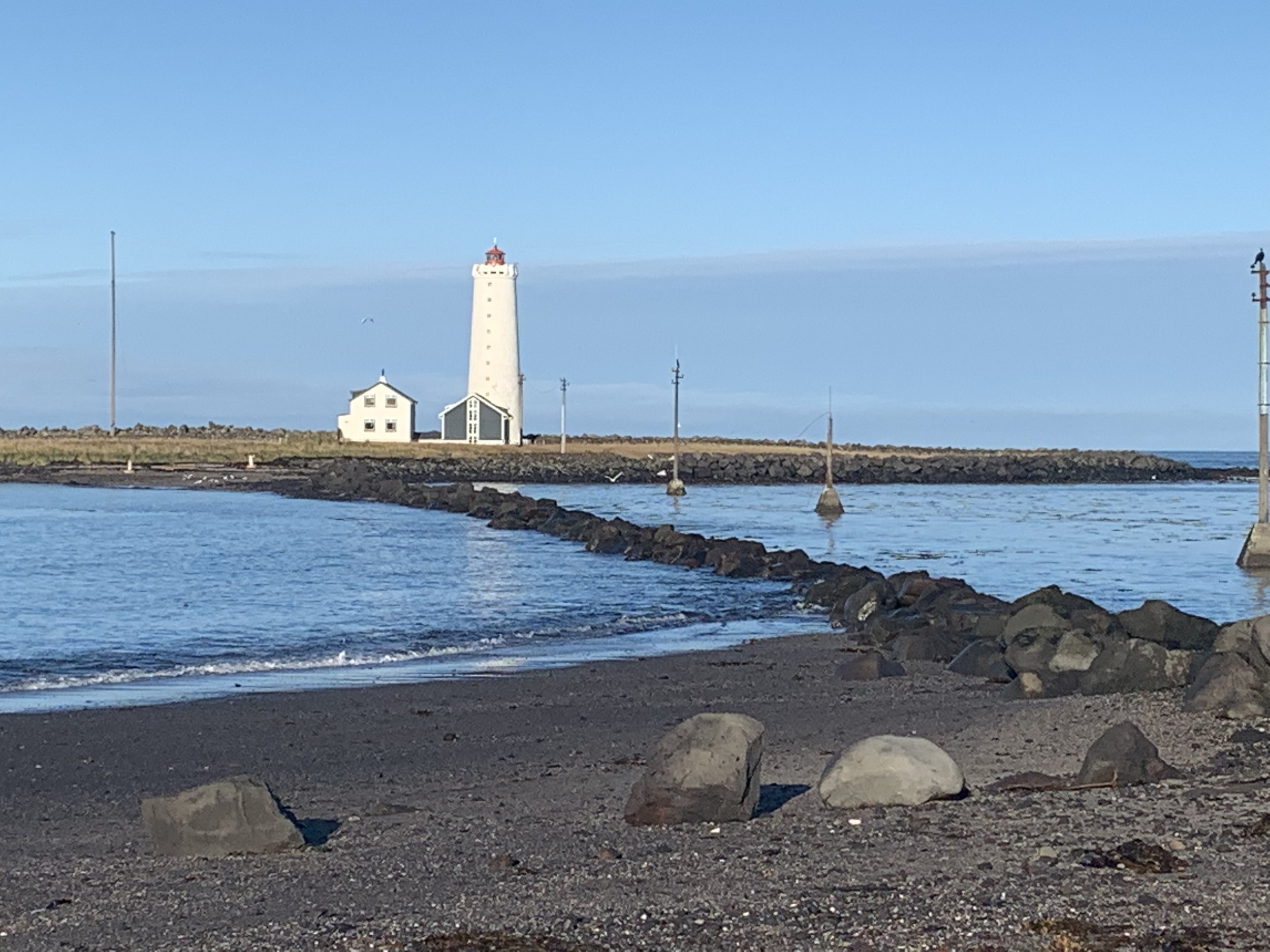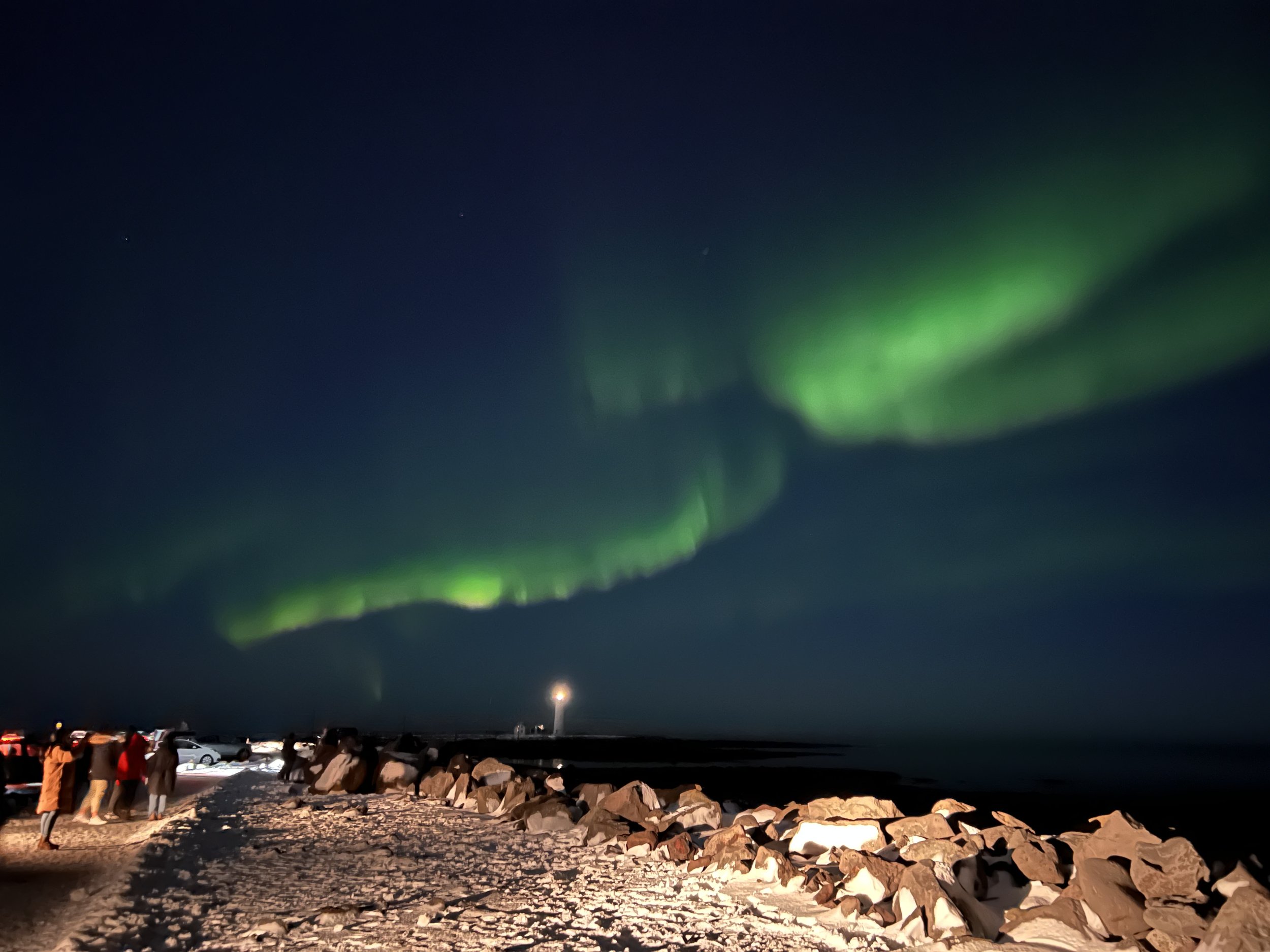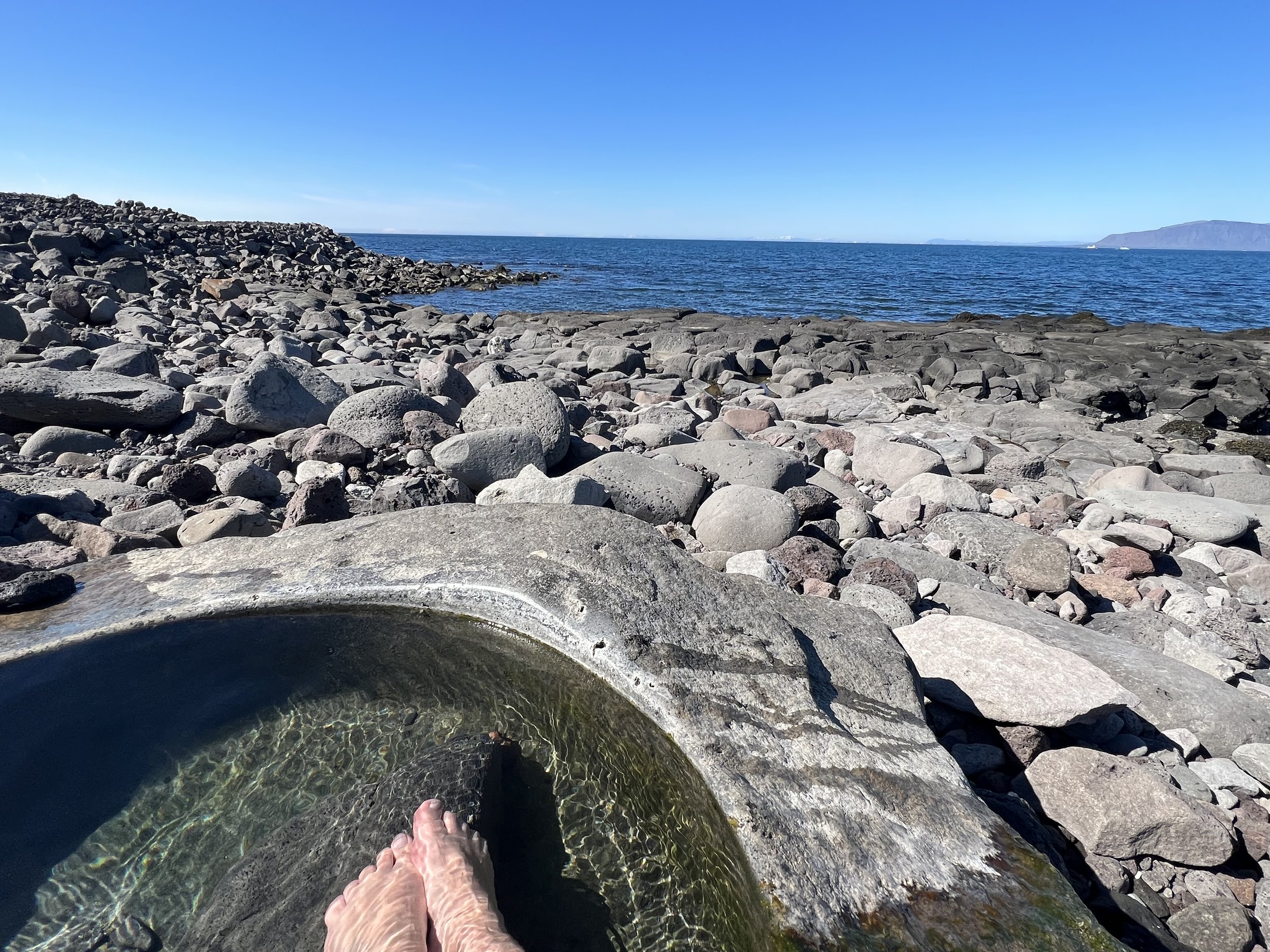Grótta Lighthouse
Grótta lighthouse seen from the mainland, with the tide coming in
On the very tip of the Seltjarnarnes Peninsula in the north-western part of Greater Reykjavík is a beautiful area, which is a nature reserve due to its abundant birdlife. This area is known for its lighthouse on the small island of Grótta, as well as for the birds that flock and nest around the lake, and it is a favourite walk for both residents and tourists alike.
The view as you look across the bay to the mountains beyond
With its rugged coastline and black sands, it is a bit of a natural oasis in the capital city. It is an easy walk from the centre of Reykjavík to the lighthouse at Grótta and you will pass many other people walking or cycling on your way there. The walk takes about an hour (although there is a bus route that heads out that way too, and you can also drive – it’s about a 10 minute drive from downtown Reykjavík, and there is a parking area by the lighthouse. It is however a lovely walk on a fine day, right along the edge of the coastline. There is a well-maintained path that runs the whole way from Reyjkavík, along the northern edge of the Seltjarnarnes Peninsula, and the views are stunning, looking across the Faxaflói Bay to Esja, Akranes and beyond to Snæfellsnes. It’s definitely worth the effort to walk it, breathing in the salty air and listening to the sound of the waves breaking on the rocks and sand below. At the end of the walk is the lighthouse itself.
Grótta Lighthouse
There has been a lighthouse at Grótta since 1897, and the one that is currently there dates back to 1947. It was connected to the electric grid in 1956 and has remained more or less unchanged since.
Historical records show that a farm existed on this site in the 16th Century, which is probably where it got its name, thought to derive from the old word for a wheat-grinding mill. The island is now uninhabited, just featuring the lighthouse itself which is fully automated.
Grótta is now one of the capital’s most visited sites, attracting both locals and foreign visitors throughout the year. It’s a place I’ve found myself returning to again and again. In the summer it is a haven for birdwatchers and nature lovers and in the winter it is one of the best places to see the Northern Lights as there is little light pollution out here.
With open skies and less light pollution, no wonder people flock here to see the lights
Grótta is linked to the mainland through a thin spit of land that is easily crossed by foot, but which then at high tide is completely covered by the sea. If you are walking to the lighthouse, you do have to be careful of the tides, otherwise, you can be stranded on the beach, and there have been many instances of visitors ending up stranded. Depending when you walk over, you can generally stay for up to 6 hours before Grótta is once again cut off from the mainland.
We were lucky enough on one visit over to the island to find that the lighthouse was open, and featured a display of dozens and dozens of pictures of lighthouses from every part of Iceland by a local artist. It was fascinating looking at the wide variety of styles and colours of lighthouses featured and was an amazing mini exhibition. I believe the artist’s goal is to paint every single lighthouse in Iceland (and there are a lot). As well as enjoying the pictures, it gave us an unexpected opportunity to see the inside of the lighthouse.
Just a few of the many paintings of Icelandic lighthouses
Bakkatjörn Lake
Looking across Bakkatjörn from the other side of the peninsula
Back on the mainland, there is a lovely wide beach which is often used by local families and a path that takes you past some of the old wooden fish drying racks, called “hjallar“ or “trönur“, which you can see dotted around Iceland, and which are used to hang fish to dry. Dried fish was one of Iceland’s first export commodities and is still a very popular snack, available in all supermarkets and food shops.
Fish racks on the peninsula
Following the path across the end of the peninsula will take you to the small lake Bakkatjörn and the golf course beyond. The birdlife is very diverse and about 106 species of birds have been seen in Seltjarnarnes. Throughout summer, many species of birds nest in the area. Seabirds, such as Arctic Terns, form a colony on the rocks, and freshwater species, such as tufted ducks, can be found on and around Bakkatjörn. I’ve been told it is also worth keeping your eyes on the shoreline for seals, which are occasional visitors, although I haven’t yet seen any here.
This is a favourite spot for many different types of birds
Throughout June, areas will be cordoned off to protect the birds which are nesting, so people are asked to stick to the walking paths. If you get too close, the arctic terns in particular will become quite territorial and aggressive, dive-bombing the heads of anyone who gets too close to their eggs or young. I have been warned off many times, although luckily not actually been attacked. Thank goodness as they have very sharp beaks!
Kvika foot bath
Kvika footbath - it has a pretty amazing view!
Another lovely, and often missed place in the area is the Kvika geothermal pool. One of the smallest geothermal hot pools to be found, this is just big enough for you to sit and warm your feet in. The water, which is fed by a nearby borehole, is toasty warm and it’s so nice to sit and soak your feet after a long walk around the bay. What makes it even better is the view across the bay to Esja and Snæfellsjöull (the glacier on Snæfellsnes). This pool was apparently designed and carved out of a huge rock by the artist Ólöf Nordal and is approximately 25-30 cm deep, 80-90 cm wide. Even though I have visited Grótta and Bakkatjörn on several occasions, I still hadn’t found the Kvika footbath until last weekend, when I set off to the area with my camera and new telephoto lens to take pictures of the arctic terns. This is just the right time of year to see lots of these pretty but feisty little birds, and as I was on my own this weekend, with Matthew being in the UK I decided it was a good opportunity to go and play with my camera without worrying about him getting bored while I waited for 20 minutes to get just the right shot of a diving tern… 20 minutes – who am I kidding?? I was there for ages! Those birds are very fast indeed and not easy to photograph!
An arctic tern landing
After a long stint walking around the lake and to the nearby golf course, plus of course a lot of standing about taking photographs, my feet were aching and I suddenly remembered that I hadn’t yet found Kvika so made that my next mission. Once you set your mind to it it’s remarkably easy to find (the the heating company pump station by the side of the road is a bit of a giveaway that you could be getting close!). Nearby, is a small wooden hut and beyond that, the foot spa itself. Never has hot water felt so good on tired feet! Shoes and socks off, I sat for a while, blissfully soaking my grateful feet in the hot water and enjoying the view, even joined for a while by a friendly local cat who was hunting out tasty creatures in the pools of water amongst the rocks.
This is such a lovely spot to while away a few minutes and soak away those aches
My little furry friend on the hunt for fresh seafood snacks
We are so lucky to have such a gorgeous area within walking distance of the apartment. It’s no wonder that the locals love this place so much. It makes for the perfect weekend walk.












